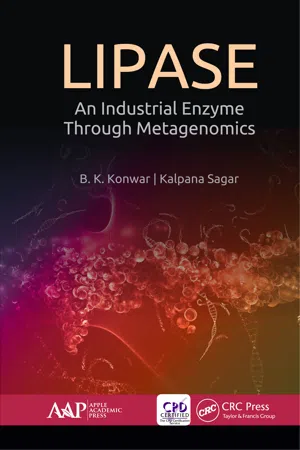![]()
CONTENTS
Preface
About the Authors
1. Introduction
1.1 Enzymes
1.2 Etymology and Historical Aspects of Industrial Enzymes
1.3 Industrial Enzymes: Development of Bioindustrial Sector
1.4 Classification of Enzymes
1.5 Lipase
1.6 Classification of Bacterial Lipolytic Enzymes
References
2. Application of Lipases
2.1 Detergent Industry
2.2 Food Processing, Flavour Development and Improving Quality
2.3 Bakery Industry
2.4 Fat and Oleochemical Industry
2.5 Textile Industry
2.6 Cosmetic Industry
2.7 Pulp and Paper Industry
2.8 Oil Biodegradation
2.9 Production of Biodegradable Polymers
2.10 Diagnostic Tool
2.11 Degreasing of Leather
2.12 Waste/Effluent/Sewage Treatment
2.13 Production of Biodiesel
2.14 Tea Processing
2.15 Biosensors
2.16 Environmental Management
2.17 Major Obstacles And Future Prospect of Microbial Lipases
References
3. Metagenomics and Unculturable Bacteria
3.1 Microbial Communities
3.2 Soil as a Microbial Habitat
3.3 Unculturable Microorganisms
3.4 Culturable Microorganisms
3.5 Microbial Species for Beneficial Products and Processes
3.6 Metagenomics
3.7 Soil Metagenomics for Desirable Genes
3.8 Soil Metagenomics: Tool for Novel Compounds
3.9 Sequence-Based Metagenomics
3.10 Function-Driven Metagenomics
3.11 Metagenomic Library Construction and its Analysis
3.12 Approaches to Metagenomics
References
4. Accessing Metagenomics
4.1 Methods
4.2 Expression Vector/Host System
4.3 Functional Screening of Metagenomic Libraries
References
5. Metagenomics for Lipase
5.1 Collection of Environmental Samples
5.2 Extraction, Purification and Quantification of Soil Metagenomic DNA
5.3 Isolation And Purification Of mgDNA from Gram+ and Gram- Bacteria
5.4 Polymerase Chain Reaction
5.5 Restriction Digestion by EcoRI, HindIII and BamHI
5.6 Metagenomic DNA Library Construction
5.7 Sequence-Based Metagenomic Approach
5.8 Construction of 16S rDNA Gene Libraries
5.9 Preparation of E. coli Competent Cells and Transformation
5.10 Analysis of Transformation Efficiency Using Non-Recombinant Plasmid
5.11 Screening of Recombinants by α Complementation
5.12 Purification of PCR Products
5.13 Transformant Confirmation by Colony PCR Using Universal Primers
5.14 Isolation and Restriction of Recombinant/ Nonrecombinant Plasmid DNAs
5.15 Analysis of 16S rDNA Gene
5.16 Phylogenetic Analysis
5.17 Genbank Submission and Accession Numbers
5.18 Phylogeny
References
6. Functional Approach for Metagenomic Library Construction
6.1 Restriction Digestion Of MGDNA
6.2 Transformation of E. coli BL21 Competent Cells
6.3 Functional Screening of Metagenomic Libraries for the Lipase Gene
6.4 Isolation and Restriction Digestion of Recombinant Plasmid
6.5 Sequencing of Cloned DNA
6.6 Sequence Analysis and Phylogenetic Tree Construction
6.7 Analysis of the Cloned Lipase Gene
6.8 Phylogeny of Recombinant Protein
6.9 Amino Acid Sequence of Recombinant Protein
6.10 Multiple Sequence Alignment
6.11 Storage of Recombinant Plasmid
References
7. Overexpression of Recombinant Protein
7.1 Purification of Expressed Protein
7.2 Determination of Active Lipase using Zymographic Study
7.3 Determination of Specific Activity, % Yield and Protein Fold Purification
7.4 Homology Model and Validation for Protein Structure Prediction
References
8. Biochemical Characterization of Purified Lipase
8.1 Dose-Dependent Enzyme Activity
8.2 Substrate Specificity and Effect of Substrate Concentration
8.3 Enzyme Kinetics
8.4 Effect of Temperature and Ph
8.5 Effect of Surfactants
8.6 Effect of Other Factors
References
9. Genomic Study of Culture Dependent Bacteria
9.1 Isolation and Screening for Lipase Producing Culturable Bacteria
9.2 Pure Culture of Lipase-Producing Bacterial Isolates
9.3 Inoculum Preparation
9.4 Zone of Hydrolysis
9.5 Growth Kinetics and Lipase Production
9.6 Thermal Stability
9.7 Evaluation of Crude Enzyme in Detergent Formulation
9.8 Stability of Culture Supernatant Under Storage
9.9 Taxonomic Identification Of Lipase-Producing Bacteria
9.10 Extracellular Enzyme Activity
9.11 Spectrophotometric Growth Determination
References
10. Genomic Study of Culturable Bacteria
10.1 Genomic DNA Extraction of Lipase-Producing Culturable Bacteria
10.2 Agarose Gel Electrophoresis
10.3 Quantification and Purity Determination of the Isolated DNA
10.4 Molecular Genetic Assessment of Lipase-Producing Bacteria
10.5 Phylogenetic Analysis
10.6 Optimization of Culture Condition for Lipase Production
10.7 Effect of Carbon and Nitrogen Sources for the Growth of Culturable Bacteria
10.8 Time Course with Lipase Production
10.9 Effect of Other Factors
References
11. Microbial Assay of Culture Supernatant Containing Crude Lipase
11.1 Determination of Antibacterial Activity
11.2 Determination of Antifungal Activity
References
12 Critical Observations
Index
![]()
PREFACE
Metagenomics, a molecular method based on direct isolation and analysis of nucleic acids, proteins and lipids from environmental samples, reveals structural and functional information about microbial communities. Microbial lipases are industrially important and have gained attention due to their stability, selectivity and broad substrate specificity. Bacteria, yeast and fungi are potential sources of lipases. The industrial demand for new sources of lipases, with different catalytic characteristics, stimulates the isolation and selection of new strains. Lipase-producing bacteria have been found in different habitats such as industrial wastes, vegetable oil processing factories, dairy plants and soil contaminated with oil and oil seeds among others. Among the various kinds of bacteria, Bacillus group exhibited interesting properties that make them potential candidates for biotechnological applications. Lipases are classified into eight families, I to VIII, based on their amino acid sequences. It is a widely accepted fact that more than 99% of microorganisms present in soil samples are not readily culturable and therefore not accessible for biotechnology or basic research. The genomes of these uncultured species encode a largely untapped reservoir of novel enzymes and metabolic capabilities. As such more than 99% of microorganisms have unique and potentially very useful abilities such as waste degradation, enzyme production and synthesis of compounds that could find use as drugs or antibiotics.
The present investigation was undertaken to explore the lipase- producing b...
